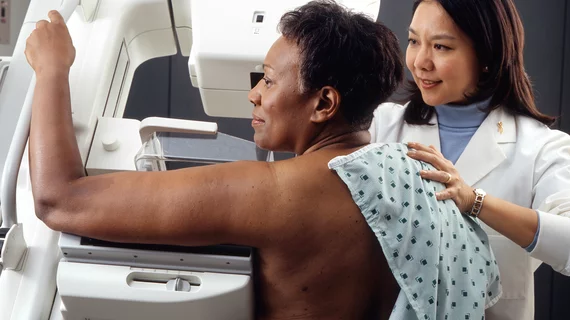Breast density notification laws were designed to motivate supplemental breast cancer screening among women at an increased risk. However, they have resulted in more low-risk women undergoing unnecessary supplemental screening, according to new research published in the Journal of the American College of Radiology.
“The variability and lack of consensus regarding supplemental screening for non-high-risk women with dense breasts presents challenges for physicians’ follow-up recommendations—the introduction of breast density notification legislation compounds these challenges,” wrote lead author Mark Manning, PhD, Karmanos Cancer Institute in Detroit, Michigan. “Breast density likely informed decision making about supplemental screening before adoption of breast density laws; however, we expect that its role was amplified after adoption of notification legislation.”
The researchers examined supplemental screening rates via MRI, ultrasound or digital breast tomosynthesis within six months of the patient undergoing a screening mammogram from 2,764 black women and 691 white women, groups the authors noted have higher incidences of breast cancer.
The study cohort had a screening mammogram between Sept. 12, 2014, and May 29, 2015, and returned for at least one screening mammogram after July 1, 2015—the date the breast density notification law was implemented in Michigan—until Dec. 31, 2016. The group also exhibited negative or benign findings at each screening mammogram.
The results indicated a five-fold increase—14 to 70 percent—in supplemental screening among “screen-negative” women after the law was implemented. The researchers noted the increase was largely attributed to an increase in supplemental screening among black women.
“Breast density was more predictive of supplemental screening and had a marginally greater explanatory role in between-race differences in supplemental screening after passage of the law,” the researchers wrote.
Sub-group analysis showed 5-year breast cancer risk was positively associated with supplemental screening before the law went into effect, but negatively associated with risk after the law for white women. The five-year risk, the researchers noted, was not associated with supplemental screening before or after the passage of the law for black women.
“We suspect that physicians were less likely to discuss breast density and associated risks or to refer appropriate black women with dense breasts for supplemental screening before the notification law, resulting in little association between risk and supplemental screening for black women with dense breasts. After the notification law, more black women with dense breasts were supplementally screened; however, it was not because they were at higher risk.”
The researchers attributed this to physicians conversations with their patients, which led to a supplemental screening referrals regardless of high or low breast cancer risk.
“Future studies ought to examine how supplemental screening rates continue to evolve as women and their physicians gain more familiarity with breast density and breast cancer risk and whether more supplemental screening yields more breast cancer tumor detection,” Manning and colleagues concluded.

